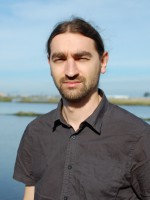resumo
Perovskite-related (La1-xSrx)(2)NiO4-delta (x= 0.5-0.8) phases were explored for possible use as oxygen electrodes in solid electrolyte cells with a main focus on the effect of oxygen deficiency on the electrocatalytic activity. (La1-xSrx)(2)NiO4-d solid solutions were demonstrated to preserve the K2NiF4-type tetragonal structure under oxidizing conditions. Acceptor-type substitution by Sr is compensated by the formation of oxygen vacancies and electron holes and progressively increases high-temperature oxygen nonstoichiometry, which reaches as high as d= 0.40 for x= 0.8 at 950 degrees C in air. The electrical conductivity of (La1-xSrx)(2)NiO4-d ceramics at 500-1000 degrees C and p(O-2) >= 10(-3) atm is p-type metallic-like. The highest conductivity, 300 Scm(-1) at 800 degrees C in air, is observed for x= 0.6. The average thermal expansion coefficients, (14.0-15.4) x 10(-6) K-1 at 25900 degrees C in air, are sufficiently low to ensure the thermomechanical compatibility with common solid electrolytes. The polarization resistance of porous (La1-xSrx)(2)NiO4-d electrodes applied on a Ce0.9Gd0.1O2-delta solid electrolyte decreases with increasing Sr concentration in correlation with the concentration of oxygen vacancies in the nickelate lattice and the anticipated level of mixed ionic-electronic conduction. However, this is accompanied by increasing reactivity between the cell components and necessitates the microstructural optimization of the electrode materials to reduce the electrode fabrication temperature.
palavras-chave
OXIDE FUEL-CELLS; X-RAY-DIFFRACTION; ELECTRICAL-PROPERTIES; HIGH-TEMPERATURE; CATHODE MATERIALS; TRANSPORT-PROPERTIES; CRYSTAL-CHEMISTRY; PHASE-DIAGRAM; MAGNETIC-PROPERTIES; LA2NIO4+DELTA
categoria
Chemistry; Science & Technology - Other Topics
autores
Kravchenko, E; Zakharchuk, K; Viskup, A; Grins, J; Svensson, G; Pankov, V; Yaremchenko, A
nossos autores
Projectos
Materials for novel concepts of high-temperature electrochemical energy conversion and storage systems (IF/01072/2013/CP1162/CT0001)
CICECO - Aveiro Institute of Materials (UID/CTM/50011/2013)
agradecimentos
This work was done within the scope of project IF/01072/2013/CP1162/CT0001 and project CICECO-Aveiro Institute of Materials POCI-01-0145-FEDER-007679 (FCT ref. UID/CTM/50011/2013), financed by national funds through the FCT/MEC and when appropriate co-financed by FEDER under the PT2020 Partnership Agreement. E.K. would like to acknowledge the doctoral grant by the Belarusian State University and Visby Programme scholarship by the Swedish Institute.



